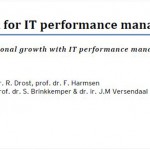Porter’s Five Forces business management model
Having a strategy in today’s competitive market can dictate the success of a business. Many companies have a business model, which may differ from one company to another. Porter’s business model is used by strategy consultants in order to study the threats and advantages a company has in its respective industry.
Business model definition
To better understand what a business model is, the 2 terms, “business” and “model”, can be explained separately. The definitions below are taken from Cambridge Learner’s Dictionary:
- Business: the activity of buying and selling goods and services, or a particular company that does this, or work you do to earn money.
- Model: a representation of something, either as a physical object which is usually smaller than the real object, or as a simple description of the object which might be used in calculations.
So, in general a business model represents an abstract comprehension of the way a company makes money: what it offers, to whom does it offer and how can it accomplish this.
Paul Timmers, in a 1998 article, defines the business model as:
- An architecture for the product, service and information flows, including a description of the various business actors and their roles;
- A description of the potential benefits for the various business actors;
- A description of the sources of revenues.
Porter’s five forces model
Porter’s five forces model is a business model used by managers to analyze the opportunities and threats posed by an industry to a specific business.
As the name states, the model focuses on 5 different forces that can influence the direction of a business:
- the risk of entry by potential competitors;
- the bargaining power of the buyers;
- the bargaining power of suppliers;
- the intensity of rivalry among established companies within an industry;
- the substitutes to an industry’s products.
Risk of entry by potential competitors
Potential competitors represent companies which are not currently competing in an industry, but have the resources to do so if they choose. A recent example can be Apple, which manufactured computers but entered the phone industry a few years ago it because it had the necessary resources.
Companies that activate in a certain industry may prevent potential competitors from entering, because the more companies within the same domain makes it more difficult for an established company to have the same profits and market share.
The bargaining power of buyers:
There are 2 type of buyers: the individual buyer (the end user) who consumes the product, or other organization who distribute the company’s product to the individual buyer. For example a company that produces bread, the product may be sold to different retailers, which then sell the bread to the end user.
If the buyer has bargaining power, it will influence the company to lower its product’s price, but maintain its high quality. This will lead to an increase in cost and decrease in profits for the company. If the situation is reversed, a company can gain an increase in profits by lowering costs and reducing the product quality.
The bargaining power of suppliers
Suppliers are organizations that provide inputs to the company. They can supply the company with materials, services or labor. If the supplier has the bargaining power, they will influence the cost of the company’s product. Alternatively if there are more suppliers a company can chose from, the bargaining power will shift to the company.
Rivalry among established companies within an industry
The fourth force in Porter’s five forces model refers to the competitors from within the same industry, which can influence the product sold by the company. This can be done by a competitor firm through its product innovation, advertising campaigns, or competitive strategy
An example may be if Samsung decides to produce a bigger smartphone, it can influence Apple to develop a bigger smartphone in order to remain competitive in the market.
The substitutes to an industry’s products
The substitutes of products refer to the existence of another product within the industry which can replace the company’s product. For example, for the companies that were producing alarm clocks, their product was replaced by smartphones, because they have integrated the alarm feature.
In Porter’s five forces business model, these forces may have different values for influencing the business. For example if a rival company lowers its prices, the bargaining power of suppliers force will have a less value because the company must adopt a different strategy. Said company can chose an aggressive strategy and lower its product’s price; a defensive strategy or a conservative one, in order to remain competitive in the industry.
Porter’s five forces model can only be a point in deciding what strategy a company should adopt. Other frameworks that can be used to create the strategy of a business might be the value chain, SWOT analysis, PESTEL or the gap map.
References:
- Osterwalder, A. (2004), The business model ontology: A proposition in a design science approach
- Rice, F.J. (2010), Adaptation of Porter’s five forces model to risk management
- Timmers, P. (1998), Business model for electronic market
Image source:

Tags: Business Strategy, Performance Management Framework






